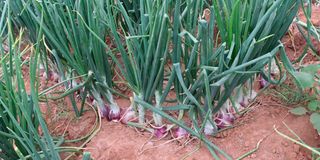Hardening onion seedlings in the bed for transplanting

Onions on a farm. While doing management practices, an onion farmer must ensure that records are kept properly. The nursery waste should also be properly disposed off.
The success of crop production begins in the nursery bed. Desmond is still carrying out nursery management practices in his onion bed to ensure the seedlings are strong and healthy.
The seeds have germinated and he has removed the mulch from the bed. It is important to determine the germination percentage as this guides on the number of seedlings to be achieved. The percentage is calculated based on the number of seeds germinated and seeds sowed.
While sowing seeds on the bed, it is not easy to calculate the germination percentage due to their small size.
The farmer should calculate based on the germinated seeds over the number of seeds per grams sowed. This is different while sowing seeds on seedling trays since the seeds are sowed per cell.
The germinated seeds are sometimes crowded in the nursery, hence the need for pricking out. Pricking out is removing excess seedlings in the nursery due to crowding and placing them in another bed where management practices are carried out until they are ready for transplanting.
This allows sufficient space for root development, aeration and easier management of pests and diseases. Since onion seedlings are small, care should be taken during sowing to prevent crowding the bed.
This also prevents increasing the cost production since more labour will allocated to perform the task.
The nursery bed should be clean to ensure it is free from fungal infection.
Prepare to start hardening off when the seedlings have four true leaves (around 20 to 25 days) after sprouting.
Hardening off is the gradual reduction in the shade and watering in the nursery bed to make the seedlings strong enough to survive in the field after transplanting. Hardening takes six to nine days before transplanting.
In this case, Desmond will reduce the number of watering from twice a day to once, depending on the weather conditions.
The shade net erected will be removed during the morning hours and placed back when the temperature is high.
Seedlings will be transplanted after six weeks when they achieve a pencil-size thickness.
While doing management practices, the farmer should ensure the records are kept well.
The nursery waste should be properly disposed of.
Degradable waste such as crop residue should be placed on the composting site while non-degradable waste that can be recycled should be stored well.
To allow easy and effective implementation of the activities, we have developed the above working plan work plan.
In our next article, we shall look at how farmer Desmond prepares his land for onion production.





